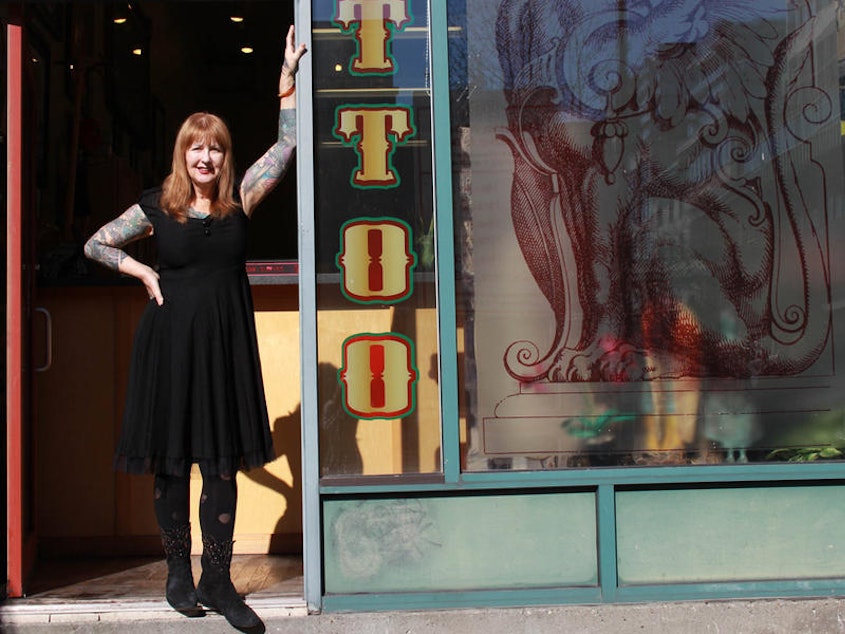Seattle Tattoo Artist Makes Mastectomy Scars Beautiful

Thirty years ago, a woman walked into Vyvyn Lazonga’s San Francisco shop and asked the tattoo artist to ink new nipples onto her chest.
The woman had undergone a mastectomy after a breast cancer diagnosis, and she wanted to recreate a semblance of the breast she’d lost.
That was Lazonga’s first foray into post-mastectomy tattooing. Although she can’t say for certain, Lazonga believes she was the first person in the country to tattoo over mastectomy scars.
“I’m not going to try to prove a point,” Lazonga says. “But it seems like I’m always a forerunner in a lot of these things.”
Including the world of tattoo artists.
As an artistic kid in Seattle, Lazonga loved to draw and bead. Then she discovered tattoos in the early 1970s. “This lightbulb went off in my head!”
Sponsored
She thought tattoos might be a good medium for her artwork. So she found a tattooist who let her help around his shop; she learned the trade watching him work.
While she was there, Lazonga began to create original tattoo designs: black and white geometric abstractions, inspired by indigenous art, as well as colorful flowers, fish, birds and other wildlife.
Her designs stood out from what the mostly male field was doing at the time. Over the years, Lazonga has been recognized by national tattoo organizations, as well as a steady stream of customers.
These days, about half of Lazonga’s clients want her to create post-mastectomy tattoos.
Lazonga plies her trade under the name Madame Lazonga out of a narrow, historic storefront on Western Avenue, just below Pike Place Market.
Sponsored
Her shop is as much a feast for the eyes as her tattoo art: colorful illustrations of her past work vie for space on the walls with dozens of plaques and awards. A Madame Lazonga marionette dances behind the main counter. Varied decorative light fixtures dangle from the shop’s high ceilings.
On a recent sunny winter afternoon, a middle-aged couple perused some of the avian designs in Lazonga’s portfolio. A dark-haired woman sat patiently in a chair on the other side of the shop.
She’s Andrea May, 44, one of Lazonga’s post-mastectomy clients. May was waiting for the customers to leave so she could begin another session with Lazonga.
May’s breast cancer was diagnosed at a routine mammogram screening. She was 40 years old. Her mother and grandmother had had the disease, so May opted to have both breasts removed, even though cancer was only detected in one.
After her surgery, May decided that, instead of undergoing reconstructive surgery, she’d get a tattoo.
Sponsored
“I wanted to replace the scars with a piece of artwork that was beautiful,” she says.
As the wife of an army chaplain stationed at Joint Base Lewis-McChord, May knew a lot of fellow military people with tattoos.
They weren’t what she had in mind. She envisioned something bigger, and more feminine; something that would cover where her breasts had been.
May found a Tacoma tattooist who inked a pink breast cancer ribbon twined around a blue cross in the middle of her chest.
But he wouldn’t tattoo over her mastectomy scars.
Sponsored
So May went online and found Lazonga.
Lazonga designed an intricate vine of roses, foliage and lace, about six inches wide, that incorporates May’s existing tattoo. A cheery bird now perches just below her left collarbone. The whole bandeau will span May’s chest when Lazonga finishes it.
Intricate tattoos like this take at least 12-20 hours to complete. Lazonga works in three-hour sessions.
May says nobody except she and her husband will ever see the tattoo. She views it as private body art, a chance to reclaim something she’d lost.
“Having a tattoo is a way of feeling better about your body, of having that place you feel like you’re in control after something that was out of your control happened to you,” she says quietly.
Sponsored
That’s exactly what tattoo artist Lazonga likes to hear.
“I don’t want to dredge up bad memories,” says Lazonga. “I just do my work and try to be compassionate.”

